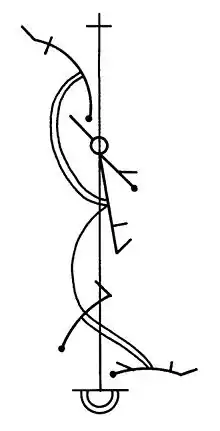
Beauchamp–Feuillet notation is a system of dance notation used in Baroque dance.

The notation was commissioned by Louis XIV (who had founded the Académie Royale de Danse in 1661), and devised in the 1680s by Pierre Beauchamp. The notation system was first described in detail in 1700 by Raoul-Auger Feuillet in Chorégraphie. Feuillet also then began a programme of publishing complete notated dances. It was used to record dances for the stage and domestic use throughout the eighteenth century, being modified by Pierre Rameau in 1725, and surviving into at least the 1780s in various modified forms.
One of the innovations of this notation was to show the music on a staff as a musician would use it, across the top of a page. Bar markings on the music are also drawn across the tract of the dancers, clarifying the relation of the steps to the music. The focus of the notation is the footwork. The notation shows the sequence of foot moves, and, for each move, the direction, the manner of executing the step, and the relative timing of the moves. There is enough detail that dancing masters, in other places and times, could reconstruct the dance and teach it from the notation alone. There are over 300 notated dances known.[1] The majority of the known dances are for two dancers, usually a man and a woman, and were intended to be performed at balls or on the stage.[1]
Notes
Reading
- Raoul Auger Feuillet (1700) Chorégraphie, ou l'art de d'écrire la danse (Paris)
- a facsimile of the 1700 Paris edition (1968: Broude Brothers)
- translated into English by John Weaver: (1706) Orchesography (London)
- translated into English by P. Siris: (1706) The Art of Dancing (London)
- Raoul Auger Feuillet (1706) Recueil de contredanses (Paris)
- a facsimile of the 1706 Paris edition (1968: Broude Brothers)
- Wendy Hilton “Dance of court and theater: the French noble style 1690–1725”
- reprinted in: (1997) Dance and Music of Court and Theater: Selected Writings of Wendy Hilton (Pendragon Press) ISBN 0-945193-98-X
- Meredith Ellis Little & Carol G. Marsh (1992) La Danse Noble: An Inventory of Dances and Sources (Broude Brothers) ISBN 0-8450-0092-6
- Pierre Rameau (1725) Le Maître à danser (Paris)
- a facsimile of the 1725 Paris edition (1967: Broude Brothers)
- translated John Essex: (1728) The Dancing Master (London)
- Pierre Rameau (1725) Abbregé de la nouvelle methode (Paris)
- Kellom Tomlinson (1735) The Art of Dancing (London)
- Gregorio Lambranzi (1716) Neue und Curieuse Theatralische Tantz-Schul (Nürnberg)
- Philippa Waite & Judith Appleby (2003) Beauchamp–Feuillet Notation: A Guide for Beginner and Intermediate Baroque Dance Students (Cardiff:Consort de Danse Baroque) ISBN 0-9544423-0-X
External links
- Wilson, David."The Early Dance Lecture 2003: But how do you know how they danced so long ago?". Archived from the original on 2012-02-16. Retrieved 2008-08-14.
{{cite web}}: CS1 maint: bot: original URL status unknown (link) - Project Gutenberg copy of the John Weaver, English language, 1706, book Orchesography, based on the Feuillet, French language, 1700, book Chorégraphie
- The books of John Weaver - Facsimiles of 18th-century English translations of Feuillet's books.
- Baroque Dance Notation by Paige Whitley-Bauguess, including an introduction to reading Beauchamp-Feuillet notation.